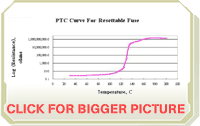 |
TECHNOLOGY BASICS.................................................................

Polymeric PTC material and device technology synergistically integrate the
advance polymer material technologies, conductive material science, novel
processing engineering, and fundamental electronic and electrical theory.
Electrical resistance of such material and devices increases with temperature
increases and vice versa. When experiencing "overcurrent and/or over voltage",
the device generates thermal energy (Energy = I*V) and heats up itself. This
makes polymer matrix's morphology change from crystalline to amorphous phase,
and results in a resistance increase of thousand orders of magnitude such
that "trip" the electricity. The device
will remain hot and stay "tripped" until the fault is cleared and power removed.
HOW DOES THE RESETTABLE FUSE WORK ....................................
FUSETRONIC resettable fuses are designed and made of patented novel
polymeric  PTC material in thin chip form, developed solely by FUSETRONIC.
With electrodes and leads attached on both sides, it is placed in
a series to protect a circuit. At "normal operating condition", the device remains at anxtremely low resistance
(mini-ohms) and allows thelectrical current to flow through it without any restriction.
When overcurrent condition occur, the Polymeric PTC material heats up, and its
resistance increases sharply. Such a sharp resistance increase (to an insulated
status) cuts off the current in the circuit, and consequently protects thelement
and device in the circuit. Upon faulty current being removed, the resettable
fuse cools and its resistance drops to the originalxtremely low value. The resettable
fuse is "resetted"; and allows the current through the circuit again. PTC material in thin chip form, developed solely by FUSETRONIC.
With electrodes and leads attached on both sides, it is placed in
a series to protect a circuit. At "normal operating condition", the device remains at anxtremely low resistance
(mini-ohms) and allows thelectrical current to flow through it without any restriction.
When overcurrent condition occur, the Polymeric PTC material heats up, and its
resistance increases sharply. Such a sharp resistance increase (to an insulated
status) cuts off the current in the circuit, and consequently protects thelement
and device in the circuit. Upon faulty current being removed, the resettable
fuse cools and its resistance drops to the originalxtremely low value. The resettable
fuse is "resetted"; and allows the current through the circuit again.
TRIP CURRENT, HOLD CURRENT AND THERMAL
DERATING .............

Trip Current (IT) and Hold Current (IH) of resettable fuse are rated at 23°C.
Typically its Trip Current is twice as much as its Hold Current. FUSETRONIC
device will not trip at its Hold Current or blow and will trip at or above its
Trip Current. However, due to the PTC effect both IT and IH reduces with ambient
temperature increase and vice versa. As shown on Figure 3, the currents are
reduced nearly 50% at 85°C and increased to 150% at -40°C.
|